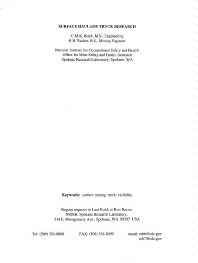Mining Publication: Surface Haulage Truck Research
Original creation date: September 1999
After numerous shakedown tests, including locating positioning, aiming, adjusting, testing, tuning, and evaluating various proximity warning systems, we concluded that the Doppler radar backup alarms appear to show promise for sensing objects within the blind areas of vehicles. Significant efforts must be made to achieve acceptable performance without false alarms. The Doppler radar discriminating alarm is not a "bolt-on and plug-and-play" unit that is easy to adapt to various situations. During the tests, it was shown that mounting the units to achieve optimum sensing ability without interference and false alarms from other systems was, at the very least, a tedious and time-consuming job. The radio frequency identification (RIFD) tag is currently undergoing antenna design modifications to improve its effective range. This system needs to be designed so that it does not sense more than the desired 40-50 ft (12.2-15.2m) range. The black-and-white closed-circuit television (CCTV) system successfully withstood a year's cycle of loading, hauling, and dumping, as well as the rigors of desert heat and cold. The floor-mounted frame isolated the unit from cab vibrations and offered the driver a single location for visual and verbal communication.
Authors: CM Boldt, RR Backer
Peer Reviewed Journal Article - September 1999
NIOSHTIC2 Number: 20000828
Am J Ind Med 1999 Sep 36(S1):66-68
See Also
- Acceleration and GPS Data Monitor Truck-Haulage Jolts
- Characteristics of Fugitive Dust Generated from Unpaved Mine Haulage Roads
- Engineering Considerations and Selection Criteria for Proximity Warning Systems for Mining Operations
- Monitoring Blind Spots: A Major Concern for Haul Trucks
- Preventing Collisions Involving Surface Mining Equipment: A GPS-based Approach
- Recommendations for Evaluating & Implementing Proximity Warning Systems on Surface Mining Equipment
- Technology News 468 - Tests of Doppler Radar Technology for Haulage Truck Backup Alarms
- Test Results of Collision Warning Systems for Surface Mining Dump Trucks
- Test Results of Collision Warning Systems on Off-Highway Dump Trucks: Phase 2
- Tying Acceleration and GPS Location Information Together To Create a Mine Management Tool
- Content source: National Institute for Occupational Safety and Health, Mining Program


 ShareCompartir
ShareCompartir
